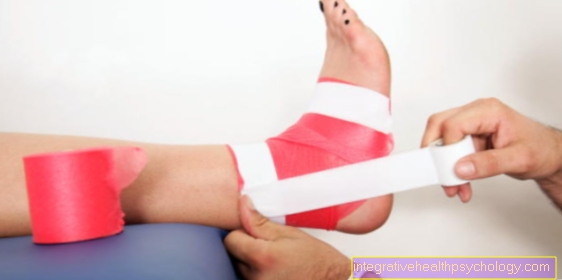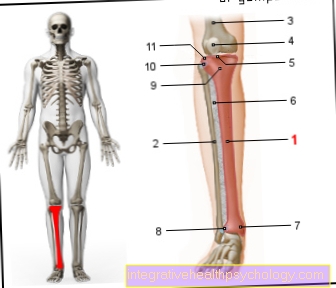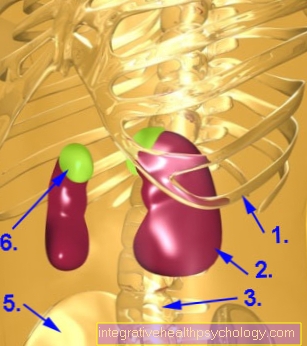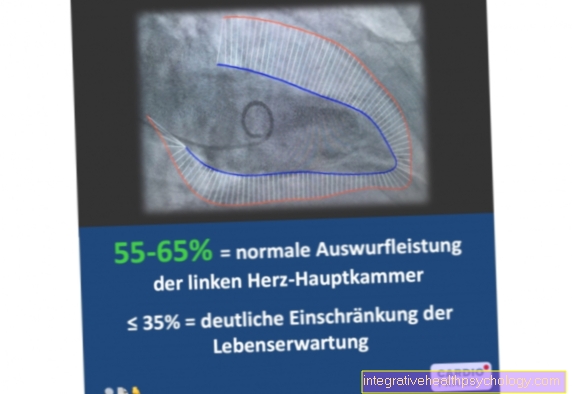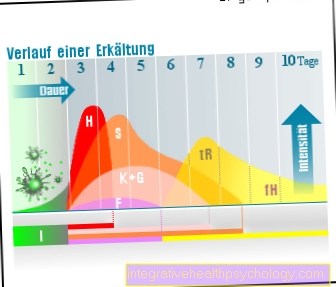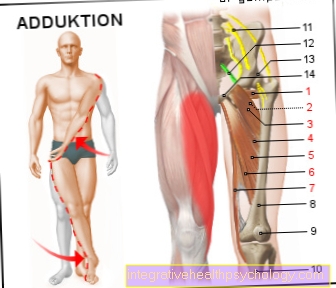What is a foot block?
definition
The foot block is a regional anesthetic procedure in order to be able to perform painless operations or wound care on the foot. Local anesthetic is injected in several places around the lower leg just above the ankle, thus blocking nerve transmission at this point. The entire foot is insensitive to pain. The mobility of the foot is not completely suppressed because some muscles for foot movement are in the lower leg. It is a process with relatively few side effects.
Read more on the topic: Regional anesthesia or central anesthesia

How is a foot block done?
After the surgery has been planned precisely and the patient has been informed, the puncture site, in this case the lower leg, is covered with sterile drapes. The puncture points, in the case of the foot block there are five different points around the lower leg, are thoroughly disinfected. The skin can be numbed locally before the actual anesthetic, so that there is no pain during the puncture. The cannula is pierced through the skin and advanced to the nerve. This can be checked with an ultrasound control. An electrical lead can also show the anesthetist whether the nerve has been hit. The local anesthetic is injected near the nerve.
Since several large nerves run in the lower leg, this process must be repeated five times until the entire foot is numb. The drug starts to work in about fifteen minutes. The foot begins to tingle and then becomes numb. As soon as the foot is completely numb, the actual procedure can begin. In most cases, a green cloth is stretched between the surgical field and the patient's head, as this protects the sterile environment. The patient can therefore usually not watch the operation.
You might also be interested in the topic: Peripheral nerve block
What are the risks?
Regional anesthesia, and thus also the foot block, is a procedure with relatively few side effects. Local allergic reactions are possible. An accidental injection into the nerve, and not next to it as planned, can cause nerve damage and abnormal sensations. In rare cases, a systemic allergic reaction, i.e. an allergic reaction affecting the whole body, can lead to allergic shock. For this reason, if you have a known allergy to the local anesthetic, another procedure should be selected.
If the local anesthetic gets into the bloodstream unplanned, stronger side effects are possible. You may feel sick, dizzy, light-headed, and restless. The anesthetist tries to prevent this by pulling back the plunger of the syringe before injecting and testing whether there is blood in the syringe. In rare extreme cases, seizures and respiratory paralysis are possible.
Local anesthetics also have an impact on the cardiovascular system. The strength of the heart and the frequency of beats decrease and blood pressure can drop. In some cases, cardiac arrhythmias develop up to sudden heart failure. Since these side effects occur particularly in patients with decompensated cardiac insufficiency or conduction disorders, another anesthesiological procedure, usually general anesthesia, should be used in these cases.
Read more on the topic: Side effects of local anesthesia
How long does the effect last?
The duration of the foot block depends on the drug administered, individual factors and the dose. Usually the effects wear off about two hours after the last injection. Another dose can be given during the procedure if otherwise the anesthesia wears off too soon. However, since some affected people break down the local anesthetic more quickly and others much more slowly, an exact time cannot be given. Regional anesthesia that has already taken place is always a clue.
Read more on the topic: Partial anesthesia
When is a foot block used?
The foot block is particularly suitable for operations and injuries to the forefoot, but can generally also be used for the entire foot below the upper ankle. The further away from the ankle, the safer the anesthetic will be. The foot block is used, for example, for:
- Amputations
- Wound cleansing (Debridements) diabetic feet
- Injuries to the toes
After accidents, a great advantage of the foot block compared to general anesthesia is that the anesthesia planning is faster and, unlike general anesthesia, no sobriety is necessary.
Read more on the topic: Local anesthesia
In which operations can the foot block be used?
In principle, almost all foot operations can be performed under regional anesthesia. The foot block is particularly suitable for operations on the forefoot and toes.
The operations include:
- Hallux valgus
- Hallux Rigidus corrections
- Amputations
- Separations of fused toes
- Removal of thorn warts
- and many other foot operations
The foot block is excluded if there is inflammation in the puncture area or the patient has a blood clotting disorder.
Which drugs are used?
Various medications can be used for regional anesthesiological procedures, including the foot block. The historically best known narcotic is cocaine. Although cocaine is actually no longer used in medicine, today's local anesthetics are based on this substance and work via similar mechanisms. Possible local anesthetics are procaine, lidocaine, bubivacaine, ropivacaine, and prilocaine.
The various active ingredients differ in their effectiveness, the onset of action, the duration of action and their controllability and can therefore be selected specifically for each use. For longer and stressful interventions, the person affected can also receive a sedative such as midazolam.
What is hallux valgus?
Hallux valgus is a crooked position of the big toe. The reason for this is the drifting of the first metatarsal bone and the associated incorrect position of the tendons. Since the hallux valgus can interfere with walking and is also called unaesthetic by many people, the deformity can be corrected surgically. This is a typical area of application for the foot block, as it is a forefoot operation. Oberst's conduction anesthesia would not be sufficient and more than the foot block is usually not necessary.
Read more about the: Hallux valgus

